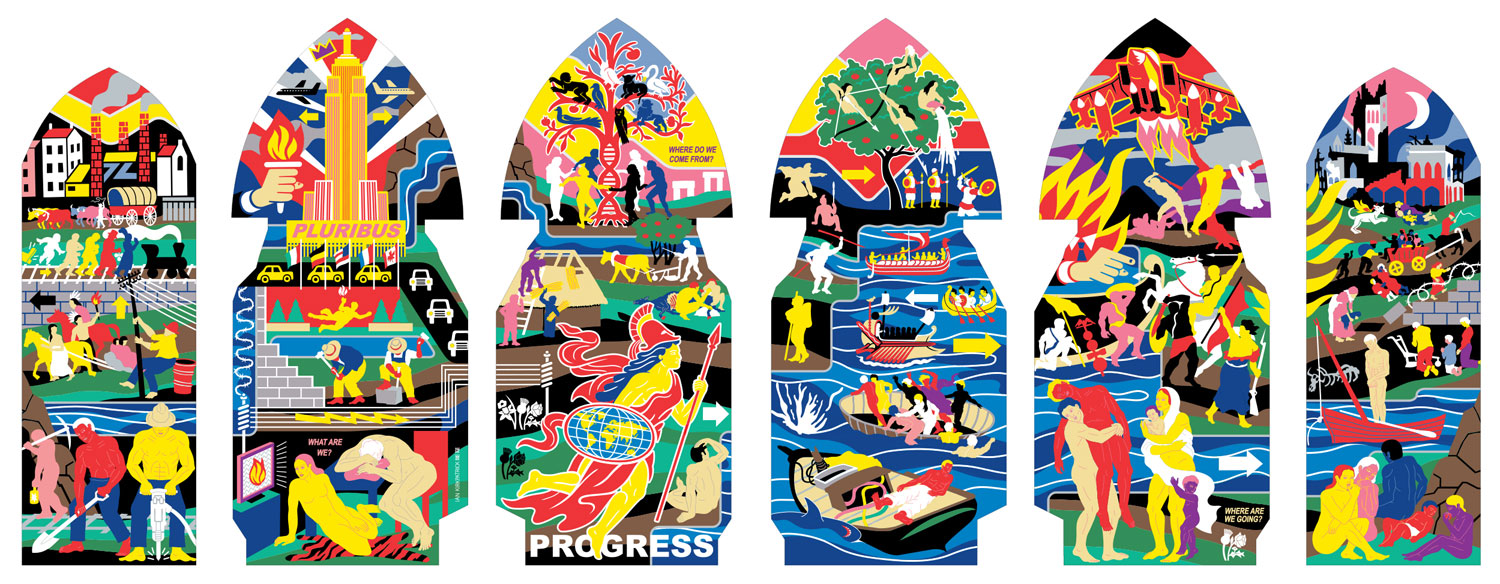
Contemporary artist and graphic designer Ian Kirkpatrick recently completed a commissioned piece for Oxford University Museum of Natural History. The piece was in response to the museum’s temporary exhibition, “Settlers: Genetics, Geography and the peopling of Britain,” and featured a series of digitally printed Dibond aluminum composite panels.
Although based in Leeds, Kirkpatrick is originally from Victoria, BC, moving to England with his wife over a decade ago. In his graphic design pieces he worked with archaeological themes with works that focused on Turkish and Egyptian design, themes that would inspire his works for years to come. His contemporary piece takes cues from ancient syntax but with a modern interpretation. As Kirkpatrick describes, “I often contrast ancient and classical iconography with modern imagery in order to show parallels between past and present.”

In his works he utilizes a diverse palette of materials including corrugated cardboard, Perspex, vinyl, stainless steel and Dibond aluminum composite panels.

For the museum showcase, Kirkpatrick created a series of six panels, four of which are located at the museum’s main entrance and the remaining two are located with the ‘Settlers’ exhibit. When describing his works he explains, “I decided to produce a big panoramic artwork exploring the different causes and effects of human movement around the world. The piece is designed like a giant landscape filled with people moving in various directions – some of them fleeing conflict zones or famine, some migrating towards cities, some exploring new lands and frontiers.”

The piece derives its inspiration from classical works as he further describes, “Much of the iconography is drawn from classical artworks like the Bayeux Tapestries, medieval manuscripts and Michelangelo’s Last Judgment. There are also figures borrowed from Diego Rivera, Goya, Winslow Homer, Lucas Cranach, and Paul Gauguin – whose painting ‘Where Did We Come From, What Are We, Where Are We Going?’ provided the title of this piece. It seemed especially relevant given the theme of the show.”

Using software like Adobe Illustrator and AutoCAD he’s able to create vector graphics and then scale them to size. And although the six panels are separated, they are intended to be viewed as a continuous loop, creating a large narrative. Kirkpatrick explains, “The narrative keeps repeating itself, and echoes the fact that the causes of human migration—both positive and negative—have been the same for thousands of years.”

This was not Kirkpatrick’s first experience utilizing Dibond as a substrate, he recently completed another large project using the material in Leeds. When seeking out a material for the exhibition he was looking for something lightweight but rigid. He had worked with the printers/fabricators at Dock Street Signs in the past and wanted to work with them again.

Interestingly, great care was taken in the installation due to the historical significance of the museum. The panels needed to “hover” in the proposed arches as no holes could be drilled. The building manager derived a clever alternative utilizing wood batons that grilled the arches and allowed the Dibond to be bolted into a framework.

Kirkpatrick further describes, “Also I knew that people would be looking at this artwork up close, so I wanted a surface that would look super crisp and exact when printed. The Dibond panels I previously commissioned from Dock Street Signs had really impressed me up close. They weren’t fuzzy or pixilated as you sometimes see with industrial digital prints – so I knew they would be perfect in this case too.”

Due to the precise measuring of the archways where the panels fit, Kirkpatrick first measured the archways and created a “point cloud” which enabled him to redraw the arches in Illustrator. Knowing the measuring so precisely allowed him to create a full-size cardboard mockup to ensure each panel fit as intended, reducing human error. For this portion he worked closely with the museum’s building manager, Peter Johnson.
Kirkpatrick has gained international recognition for his now signature style of art. His colorful works and his depth of artistry are showcased in his unique palette of substrates. With his first public sculpture being debuted in Leeds and a skyscraper mural in Amsterdam, Kirkpatrick shows no signs of slowing down. Looking forward to his future works, 3A Composites is always appreciative to be a part of an artist’s vision.
information and photography courtesy of Ian Kirkpatrick

